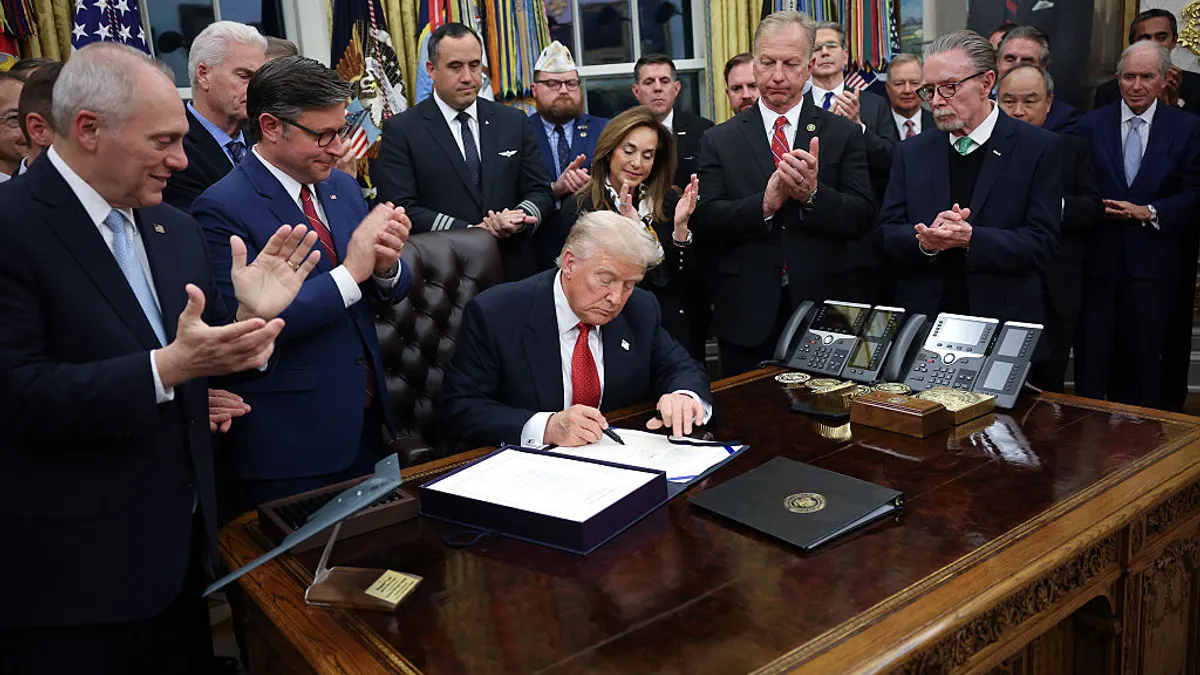Federal education staff are returning to work after a weeks-long federal government shutdown that halted many U.S. Department of Education activities ended Wednesday. However, the agreed-upon plan to open the government is only temporary.
The continuing resolution signed into law Wednesday funds schools at fiscal year 2025 levels. This temporary spending plan expires Jan. 30, unless Congress agrees to a more permanent budget before that deadline.
The deal nullifies the reduction-in-force notices sent to 465 agency employees on Oct. 10. The Education Department is also prohibited from issuing additional RIFs through the end of January and must provide back pay to all employees who did not receive compensation during the shutdown.
Government shutdown is over, and we're baaackkkkk!
— U.S. Department of Education (@usedgov) November 13, 2025
But let's be honest: did you really miss us at all? pic.twitter.com/erql7eLOeG
In a statement to K-12 Dive on Thursday, the Education Department said that it "brought back staff that were impacted by the Schumer Shutdown," in a reference to Senate Minority Leader Chuck Schumer, D-N.Y.
In Senate floor remarks Nov. 10, Schumer said, "The last 41 days have exposed the depths of Donald Trump's cruelty. He shut the government down longer than any president in American history and took innocent kids, veterans, and federal workers as political hostages, all because he refuses to do anything — anything — to fix the healthcare crisis and instead keeps pushing policies that will cut people’s coverage even more."
The statement from the Education Department added that the "Department will follow all applicable laws" and that all employees coming off furlough are back to active duty.
However, the American Federation of Government Employees Local 252, which represents more than 2,700 U.S. Department of Education employees, said the return to work for agency staffers has been "rocky."
Rachel Gittleman, president of AFGE 252, said in a statement Thursday afternoon that employees have not received official notices from the Education Department’s human resources office to return to work. Rather, they are relying on text messages from supervisors or colleagues. Gittleman added that many employees named in the October firings are locked out of their computers and do not have access to agency email.
"This disorganization and chaos only further demoralizes the hardworking public servants at the Education Department that have faced threats, harassment, illegal firings — and 44 days without paychecks," Gittleman said.
Shutdown impacts
The shutdown — the longest in U.S. history — began Oct. 1 after Congress reached an impasse on spending for FY 2026. While day-to-day K-12 and higher education operations stayed mostly unaffected, the federal shutdown put a pause on Office for Civil Rights investigations, new grant-making activities and technical assistance support.
Still, some disruptions trickled down to early childhood programs and K-12 school systems.
The National Association of Federally Impacted Schools, in a Nov. 7 statement, warned that delays in Impact Aid payments, which help school systems that are located in areas with non-taxable federal property, were "destabilizing school districts across the country."
NAFIS Executive Director Cherise Imai said that funding delays were not only inconvenient, they were "dismantling student support systems and threatening the stability of entire communities.”
The association said a survey of 90 federally impacted school districts found that more than one-third were feeling budget pressures, with many cutting programs, freezing hiring and drawing on reserves to stay open.
Early in the shutdown, it was expected that athletics and extracurricular activities at Department of Defense Education Activity schools would be paused, but those events were later deemed excepted activities during the lapse in appropriations.
Although the federal government has reopened, uncertainty remains. According to a Nov. 10 posting by Tara Thomas, senior government affairs manager at AASA, The School Superintendents Association, "the agreement does not provide superintendents with any additional certainty regarding education funding for the 26-27 school year."
Staffing levels at the Education Department remain quite lean as well due to layoffs, buyouts and attrition that occurred prior to the shutdown. According to a court filing from Nov. 12, the total number of Education Department employees is 2,536, down from 4,133 when Trump was inaugurated Jan. 20.
In early childhood education, the shutdown caused nearly 10,000 children to temporarily lose access to federally supported Head Start centers after funding lapsed, according to the National Head Start Association.
Head Start provides early childhood education services for children from low-income families. NHSA said the shutdown caused thousands of parents to lose child care services and cut access to healthy meals at the same time federal benefits for the Supplemental Nutrition Assistance Program expired Nov. 1.
In a Thursday statement, Yasmina Vinci, executive director of NHSA, credited the Head Start workforce for using emergency funds, working without pay and working with community partners to keep most Head Start programs open.
“This shutdown exposed how deeply we rely on a workforce that is underpaid, overextended, and yet unwavering in its commitment to our nation’s most vulnerable children,” Vinci said.






















